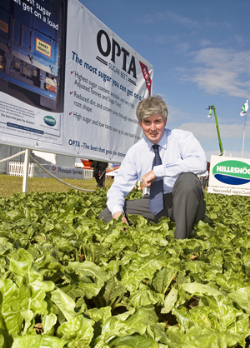
Sugar beet growers should not rely on a high disease resistance rating alone to protect their crops from Powdery Mildew attack this summer, according to Richard Powell, UK Manager of Hilleshög Sugar Beet.
"With all beet varieties it's not a case of whether to apply a fungicide, but when," he advises, "All growers should be using a fungicide, as much for the physiological greening and yield effect as for disease control. Independent trials have shown yield gains of at least 5% even under low disease pressure.
"The difference in when Powdery Mildew will breakout between a variety with a resistance rating of eight and that of two can be less than a week, if spores are present and conditions conducive; the difference between a score of four and six may be just a couple of days."
He advocates growers that should plan to spray all of their crops when the first signs of disease are seen in their most susceptible variety. "British Sugar trials have repeatedly demonstrated that beet crops will provide a valuable pay-back from an early Powdery Mildew fungicide timing. Trials have shown growers will get valuable curative control of Powdery Mildew with the new fungicide, Spyrale, but it has proven far more effective if they spray before disease gets into the crop."
A high score for resistance to late season diseases, particularly Rust, may enable growers to get away with just one fungicide treatment - particularly if they used the more persistent new Spyrale for the early season application.
Varieties with a low disease resistance for Rust may require a second application, depending on the regional and seasonal disease risk, and their intended time for lifting, he says. The Rust weakness of current Rhizomania tolerant varieties will mean all but the earliest lifted crops may need two fungicides.
Mr Powell added: "Our new Hilleshög variety, OPTA, is well-suited to a single fungicide spray programme. It will benefit greatly from the early and persistent Powdery Mildew control of Spyrale, enabling it to achieve its full potential for sugar yield. But, it has good resistance to the foliar diseases, like rust, that appear later in the season, and shouldn't require a second fungicide application.
"With the highest sugar content yet achieved in sugar beet and the new low-tare Hilleshög root shape, Opta can deliver 10% more sugar per load than the current market leading varieties."
Syngenta Crop Protection Sugar Beet Manager, Alison Pawson, reports UK field trials by British Sugar and Armstrong Fisher last year demonstrated the value of Spyrale as the early season application, in providing far greater and more persistent control of all three key sugar beet diseases than flusilazole + MBC (Punch C).
"The cost of Spyrale is comparable to a flusilazole/MBC mixture, yet growers get more control and greater persistence - leading to higher yields and more sugar per hectare. UK trials have shown an average yield increase of six tonnes per hectare from Spyrale use." This could almost certainly be a critical component in achieving and exceeding the British Sugar Target 70 tonnes per hectare yield initiative.
For crops lifted through October and November, Mrs Pawson advocates a single Spyrale application in July, to control disease and retain green leaf. For crops destined for later lifting where Rust and Ramularia is a threat, a second application in August will maintain green leaf for longer to maximise sugar yield.
